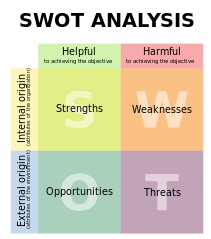 As an agency who is always looking to team up with marketing-centric, growth-oriented companies, I’m constantly baffled by the number of prospective clients who tell me that their competitive edge is that “we’re honest,” or “we care about our customers,” or “hey, we’re very good at what we do.” The next obvious question then is how many of their competitors say they are not very honest, they don’t really care about their customers, and they’re not very good at what they do?
As an agency who is always looking to team up with marketing-centric, growth-oriented companies, I’m constantly baffled by the number of prospective clients who tell me that their competitive edge is that “we’re honest,” or “we care about our customers,” or “hey, we’re very good at what we do.” The next obvious question then is how many of their competitors say they are not very honest, they don’t really care about their customers, and they’re not very good at what they do?
We’ve all gotten so wrapped up in what we perceive to be our strengths, what we “know” the market wants, what the reasons are that customers purchase our products and services (or at least should do) that we are in danger of not seeing the forest through the trees. We spend our time thinking up strategies, putting time against newer ways of reaching customers and prospects with the ever-increasing tactics of social media, etc. But we seldom, if ever, take the time to stand back and reflect where the company stands in the real-world, as the marketplace sees us.
As marketers, we know the importance of doing a SWOT analysis – Strengths, Weaknesses, Opportunities, and Threats – usually before companies rebrand themselves or new products are launched. SWOT needs to be a central part of our marketing efforts before the strategy development, before the tactical implementation, before undertaking new methods of communicating and measuring the effectiveness of our communications. In fact, when was the last time your organization or your marketing partner put together a brutally honest, no-holds-barred SWOT analysis? If you’re like most, it’s been a while.
In larger companies, marketing departments have annual planning cycles. In smaller companies, the routines are not as formalized, and planning has a tendency to be less frequent and with less time devoted to it. Generally this process looks more at budget allocation, new initiatives to be considered or implemented, staff/services cut-backs, etc. But hardly ever (ok, with less frequency than one would think) does this planning examine not just the strategy and tactics employed but how marketplace changes may have changed the company’s strengths, opportunities, weaknesses, and threats at the most basic level.
This needs to be done on a regular basis before time and resources (financial, staff, etc.) are committed to a strategy, an approach, or new tactics. Important questions need to be asked, and too often the most basic questions are not asked.
We all know them: What are our strengths? Are the strengths recognized by customers and prospects? Do our competitors have the same strengths? What are their strengths? And so on. How has the marketplace changed? Where are the new opportunities? Are our products/services adversely affected by emerging trends? How are our competitors reacting to the changing marketplace? Etc.
So I am NOT suggesting that the Marketing Department doesn’t know how to approach the marketplace or that we don’t know what we need to know. I am, rather, suggesting two things:
1. We need to set aside some time, on a regular basis, to carefully put all these questions and the answers together, and only then plan, create the strategy and implementation tactics.
2. We need to test our assumptions – every time – against what is happening in the real-world, on the ground, where the customers live and where our revenues come from.
With everything on Marketing’s plate today, and the urgency in which it needs to get done, there’s a real danger of losing sight of the basics. Who has the time, right? Well, if we lose sight of the need to regularly and carefully look at what we think our company is (warts and all), look at all that we do, and all the resources we use/spend, in the ever evolving marketplace – not just our guesses about it and our customers – we risk losing all that we work so hard to achieve: increasing revenues and market share.
The time tested marketing adage of “If you don’t really know where you are, it is much more difficult to get where you want to be” has never been more true.
 Over the weekend, my daughter wanted to update the look of her bedroom to reflect, as she told me on more than one occasion, …the “new her.” Well, as we finished painting and as she started moving the furniture around and bringing new stuff into the room as well, it occurred to me that she was just “refreshing” the look of the room and not “rebranding” who she was as a person. You see, while the color of her room had changed, a lot of other things remained the same because they spoke to who she is and what’s important to her. And the same thing holds true for companies…maybe yours, as well.
Over the weekend, my daughter wanted to update the look of her bedroom to reflect, as she told me on more than one occasion, …the “new her.” Well, as we finished painting and as she started moving the furniture around and bringing new stuff into the room as well, it occurred to me that she was just “refreshing” the look of the room and not “rebranding” who she was as a person. You see, while the color of her room had changed, a lot of other things remained the same because they spoke to who she is and what’s important to her. And the same thing holds true for companies…maybe yours, as well.
And herein lies the question: When the need arises, should you be rebranding or just refreshing your brand?
As we know, rebranding your business can be an intensive process that can literally redefine a company from the ground up. It’s more than just slapping on a new coat of colors. Instead, a rebrand is a complete redo of an already established brand because the brand has become somewhat stale, insignificant, or are just dated. This often happens when the brand has been around for a while, regardless of size or industry. Contributing factors include: aggressive competition, becoming “lost in time” with an aging customer base, or industry changes that begin to turn a company’s brand irrelevant.
However, rebranding a company from the ground up might not be the best bet for several reasons. For one, rebranding a company tends to erase history in the mind of the customer and you not only run the risk alienating current customers but confounding prospective customers. Oh, and don’t forget about the money that’s involved. Still, for many businesses, it’s necessary in order to stay competitive.
However, it is possible to take a small-scale approach by simply refreshing your brand. Think of it as remodeling your home. It’s still the same house that keeps you safe and warm; you’re just replacing the dark brown shag carpeting with hardwood floors and the yellow tile countertops with granite. It’s more of a remodel of your existing brand than a complete rebuild.
Ok, so why should you be considering this option? Well, if your company has been around for a while, maybe it’s time to revitalize your dated look, or make it more appealing to a contemporary audience, or target a new audience, or address current market conditions. This involves revising/reinvigorating a brand’s positioning and branding imagery to ensure that the messaging is not only strategically sound, but that the brand’s look is up-to-date while still keeping much of the brand’s equity. In short, it’s less of an overhaul, and more of a clarification. The brand name is left untouched, but there are changes in the logo design. Maybe it’s the sizing, placement and type of images and graphics to be used or additional shades of brand colors. It could be a new look to your website, packaging or a change in the tagline.
With this in mind, here are five things are worth considering:
Refreshing your brand is no walk in the park. It takes a lot of preparation and hard work to do it right, but it can help to ensure your brand stays fresh and continues to resonate with your customers. What better way to say “hey, we’re changing with the times” than to refresh your company image.
 Businesses everywhere are searching with ever-increasing frenzy for the wonder drug that’s going to help their businesses do more sales. A few years ago it was search engine optimization. Today it’s social media marketing. My take on this is to do your company a favor and save your money because using social media as a pathway to sales is almost certainly not going to work to the degree you want. What? Heresy you say?
Businesses everywhere are searching with ever-increasing frenzy for the wonder drug that’s going to help their businesses do more sales. A few years ago it was search engine optimization. Today it’s social media marketing. My take on this is to do your company a favor and save your money because using social media as a pathway to sales is almost certainly not going to work to the degree you want. What? Heresy you say?
You see, while social media can be a valuable marketing tool, it’s not magic, it is not a miracle, and it cannot and won’t replace everything that came before it. By itself, social media doesn’t work well. I realize what I’m saying is not likely to be well-received, especially with the hundreds of people who have set themselves up as social media experts over the last year. I can understand why people think social media will cure everything, but I challenge anybody reading this to produce a real success story that has led to an actual increase in sales.
Just take a look at the top brands on Facebook (www.fanpagelist.com/category/brands) to see which brands people Like and Follow on Facebook and Twitter respectively. It’s hard not to be amazed. The #20 brand (Skittles) has more fans than there are people who live in Texas! Yup…Texas. Wow! Who needs paid media when you can reach a mass audience for free? Surely that’s an opportunity just too good to miss, right? Surely it makes sense to place a chunk of your limited and stretched marketing budget on a social media expert who promises to get your message out there so that the profits will roll in. Right?
Well, hold on for a reality check. One significant fact is that most of the top social brands continue to invest heavily in traditional media. Coke is near the top of the top brands on Facebook with more than 70 million followers. WalMart has over 30 million. The route to social media success, it seems, runs through traditional channels. Even the exceptions like YouTube and Starbucks are worth looking at. They obviously didn’t grow into superstar brands using Facebook and Twitter but rather use social media to capitalize on brand equity they have already built-up. In fact, when Google started getting serious competition, they started running TV ads. When there’s a product launch, a sale or just about any other occasion where you need to reach a mass audience quickly and effectively, there’s still no substitute for paid media…and the dot com’s know it.
Social media is a long, hard row to hoe. There’s no quick success and very few programs break through. Ask any company in the country and they’ll tell you they have some kind of social media program in place. Some of the more active companies write a few blog posts a week; reply to comments and questions on a daily basis; and update their Twitter and Facebook feeds repeatedly. A tiny, tiny proportion of them are having anything that resembles significant impact. Fact is, Coca-Cola says it can find no correlation between “buzz” on Twitter and actual unit sales. Auto manufacturer Nissan admits it has no idea if social media helps it shift cars. MasterCard can’t tie its social investment to revenues. In fact, there remains little evidence social media does anything to boost brands’ bottom lines.
Our firm’s experience has been pretty much the same. Although LinkedIn groups were helpful in the beginning, Facebook and Twitter were almost useless for the first year. It took awhile to build a following and learn how to develop it before we saw any benefits that justified the effort.
Oh, and let’s not forget about that group of mysterious online people out there that supposedly hold all the cards … the “Influentials.” Tap into them and they’ll disperse your message to the masses, or so some would have us believe. The fact is that in-depth research into the matter finds this whole idea completely baseless. Brands like Apple, Harley Davidson and Trader Joes, for instance, have been able to build an army of passionate followers without an “influencers” strategy.
That doesn’t mean that influence doesn’t exist. It does. TV show host Oprah Winfrey is very influential as doctors are when it comes to health issues, clergy for spiritual issues and so on. However, there’s nothing mysterious about them. Marketers have long used celebrity endorsements, trade marketing and community outreach where appropriate. The truth is that brands are not built by influential people, but by influential ideas. The problem is that so called “influencers” aren’t that much more influential than anybody else. Don’t take my word for this. Go online and do your own research and see for yourself.
Again, social media by itself is not a great way to build a brand. You’re just inserting yourself into an ocean of jumbled voices and are unlikely to stand out. Marketers like to complain about the clutter in traditional media, but in social media it’s so much more cluttered.
So then why use social media at all? The reason is that it is an impactful vehicle for empowering advocacy and we know that’s extremely important for brand health and profitability. Social media, if done right, can capitalize on what brand equity your company has already built up.
So when I hear social media “experts” who make outrageous claims, who state misleading research, who use everything from stories to rumors to masquerade as facts, whose bias renders them short of perspective, and who completely dismiss the power of ‘traditional’ advertising… they’re ONLY, ONLY, voicing their opinion and not “showing me the beef.”
While social media is a vitally important component of an overall effort, it’s no replacement for sound marketing principles.
 A few weeks ago, I was faced with needing to find a new dentist. So, the search began and the more I looked around, the more it showed just how many touchpoints came into play prior to – and after – a selection being made.
A few weeks ago, I was faced with needing to find a new dentist. So, the search began and the more I looked around, the more it showed just how many touchpoints came into play prior to – and after – a selection being made.
As we know, customers experience your brand in numerous ways and each of these touchpoints molds the customer’s impression of your company’s brand. If the brand is a promise you make, then the customer experience is the fulfillment of that promise. The customer experience can’t be left to chance. It has to consistently reinforce the brand promise across every customer touchpoint or the value of the brand itself is at risk.
So, after thinking about what your brand stands for and what sets it apart, it’s time to look outward. After all, if a brand is built and nobody hears it, does it make a sound? In not-so-distant marketing past, reaching consumers meant connecting through just a few channels: a catalog, a radio spot, a store visit, a customer service line, a salesperson…You get the idea. However, the number of channels for reaching customers has exploded in recent years. Think about it: when was the last time you made a major (or even not-so-major) purchase decision, personal or for business, whether a product or service, through a single channel? In fact, it’s more likely that your purchasing decision was made after being reached through a variety of interconnected touchpoints, from social media, to word-of-mouth, to advertising messaging, to conducting research online, to comparison shopping in the store.
Despite the desire to “silo” marketing channels, they’re far more effectively used together than individually. In a Forrester’s research report, it was noted that 33% of new customers involve two or more “trackable touchpoints,” and nearly 50% of repeat customers visit three or more “trackable touchpoints.” And despite the fact that nearly a 50% of the surveyed people believed that social media channels are a great place to discover new products, less than 1% of sales resulted directly from a social media referral. Online search (i.e., Google) and email were much more effective at closing a sale.
That said, your ultimate goal is to have each touchpoint reinforce and fulfill your marketplace promise. The best way to do this effectively is to look at each of your marketing, selling, and servicing processes which then allows you to create a simple touchpoint chart or map that defines your customers’ experiences with your brand.
Keeping this in mind, let’s use the process in looking for a new dentist:
That said, all touchpoints are not created equal. Some will naturally play a larger role in determining your company’s overall customer experience. To determine the touchpoints driving your customers’ overall experience, your organization can use a wide array of techniques ranging from quantitative research to institutional knowledge.
Yes, it’s simple….almost absurdly simple. But stepping into consumers’ shoes is an exercise absolutely too many executives neglect when marketing. We forget to become our own customers–with real, day-to-day concerns–and in the process, we lose sight of the most valuable touchpoint opportunities. Each one is a chance to present your brand and what you stand for.
In other words, having a more refined sense of “touch” has a big impact on how your prospects feel.
 What does this popular country song by Johnny Lee have to do with this blog post? Well, this week my neighbor received a really attractive offer from a company with whom I’ve had a long standing relationship. When I called the company and asked if I could get the same offer, I was told “Sorry. That’s for new customers only.” When I then asked what offers did they have for current customers, I was told they’d get back to me on that. I have yet to hear from them.
What does this popular country song by Johnny Lee have to do with this blog post? Well, this week my neighbor received a really attractive offer from a company with whom I’ve had a long standing relationship. When I called the company and asked if I could get the same offer, I was told “Sorry. That’s for new customers only.” When I then asked what offers did they have for current customers, I was told they’d get back to me on that. I have yet to hear from them.
So, with that in mind, have you noticed how many companies offer deals only to new customers? Sign up for our new program and the first month is free! Special gift for new customers only! Try our new product and we’ll give you more than you asked for! Here’s the problem with those type of offers: They focus on new customers and not the ones you already have. As a loyal customer of that business, it would be nice if you could take advantage of some of those special offers too. Trouble is that they’re for new customers only. You, on the other hand, have been supporting the business for years but you get nothing. Nothing for your dedication and loyalty.
Most people think that growing a company’s sales means getting new customers. Well, yes and no. Yes, new customers are constantly needed, but truly successful companies prosper on their ability to keep the customers they’ve already acquired. The reason is simple. Finding new customers is expensive and time consuming. For example, let the following research statistics wash over you….
Not to mention that current customers give invaluable feedback on “how we did” or “how the product/service is doing” along with being a major source of referrals, etc. That’s why losing a good customer to the competition is always a bad thing. You have to work more than 10 times as hard to get enough new customers just to make up the revenue lost with your departing one, and forget about profit.
Which brings me to the question that begs to be asked: “Why do customers leave?” Curiously, most business owners and managers have the exact wrong idea about why customers leave. Most people believe that customers leave because:
(Drum roll please)…Wrong!
According to an in-depth study by the research firm CRMGuru, the reasons customers give for taking their “business down the road” are:
As you can see, when it comes to keeping your existing customers, customer service is 3 times more important than price–and 5 times more important than functionality. Which obviously means that if you want to keep the customers that you’ve got, you should think about reversing priorities and pay more attention to customer service and quality–and, consequently, less attention to functionality and price. I fully realize that this runs contrary to 90% of what most people think is important, probably because price and functionality can play a large role in new customer acquisition.
So what can be done to maximize the value of your most valuable asset? Here are five quick thought starters:
Regardless of what you’re selling, your long-term profitability is largely dependent upon your ability to keep current customers, rather than acquiring new ones. While it’s fine to try things to attract new customers to your business, be sure to spread a little love around to those who are already in your camp and are supporting your business. Don’t forget, every now and then, to “dance with the one that brung ya.”